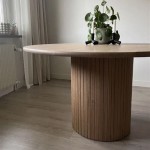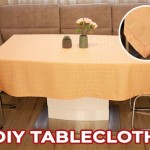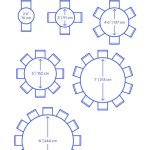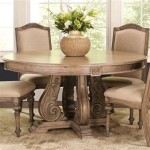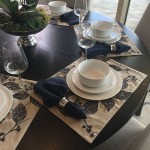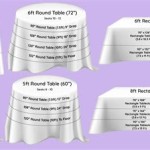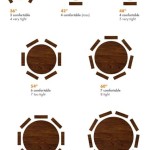Best Placemats For Your Kitchen Table: A Comprehensive Guide
Placemats are more than just decorative elements for a kitchen table. They serve a functional purpose, protecting the table's surface from heat, scratches, spills, and general wear and tear. Choosing the right placemats involves considering several factors, including material, durability, style, ease of cleaning, and price. This article provides a detailed overview of the best placemats available for kitchen tables, categorized by material and highlighting their respective advantages and disadvantages.
Understanding Material Options
The material of a placemat significantly impacts its performance, aesthetics, and longevity. Common materials include vinyl, silicone, fabric (cotton, linen, polyester), cork, and wood. Each material presents unique characteristics that make it suitable for different lifestyles and preferences.
Vinyl Placemats: Vinyl placemats are popular due to their affordability, water resistance, and ease of cleaning. They are typically made of PVC (polyvinyl chloride) or a similar synthetic material. A simple wipe with a damp cloth usually removes spills and stains. Vinyl placemats are available in a wide range of colors, patterns, and textures, making them a versatile choice for various kitchen decors. However, vinyl placemats may not be as heat-resistant as other materials, and some cheaper versions can feel thin and flimsy. They may also lack the sophisticated aesthetic of natural materials.
Silicone Placemats: Silicone placemats are known for their excellent heat resistance, non-slip properties, and durability. They are typically food-grade and dishwasher-safe, making them a hygienic and convenient option for families with young children. Silicone placemats can withstand high temperatures, protecting the table from hot dishes and cookware. Their non-slip surface helps to keep plates and glasses in place, reducing the risk of spills. However, silicone placemats may not be as aesthetically pleasing as some other materials, and their color options are often limited to solid colors.
Fabric Placemats (Cotton, Linen, Polyester): Fabric placemats, particularly those made of cotton or linen, offer a classic and elegant look. They are often available in a wide variety of prints, patterns, and textures, allowing for easy coordination with kitchen linens and décor. Cotton placemats are absorbent and relatively inexpensive. Linen placemats are more durable and offer a more refined appearance. Polyester placemats are stain-resistant and wrinkle-resistant, making them a practical choice for everyday use. However, fabric placemats require laundering, which can be time-consuming. They are also more susceptible to staining than vinyl or silicone placemats.
Cork Placemats: Cork placemats provide a natural and rustic aesthetic. They are heat-resistant and absorbent, protecting the table from heat and spills. Cork is also a sustainable and eco-friendly material. However, cork placemats can be more difficult to clean than vinyl or silicone placemats. They may also be prone to chipping or cracking if not properly cared for. Spills should be wiped up immediately to prevent staining.
Wood Placemats: Wood placemats offer a durable and sophisticated look. They are typically made of hardwood such as maple, oak, or walnut. Wood placemats are heat-resistant and can add a touch of warmth and elegance to the kitchen table. However, wood placemats require careful maintenance. They should be cleaned with a damp cloth and dried immediately to prevent water damage. They may also require occasional oiling to maintain their finish. Wood placemats can also be bulkier and heavier than other types of placemats.
Factors to Consider When Choosing Placemats
Selecting the right placemats for a kitchen table involves considering several factors beyond just the material. Durability, style, ease of cleaning, and cost all play a crucial role in making an informed decision.
Durability: The durability of a placemat depends on the material and construction. Vinyl and silicone placemats are generally more durable than fabric placemats, as they are less prone to tearing and staining. Cork and wood placemats can be durable if properly cared for, but they may be more susceptible to damage from water or impact. Consider the frequency of use and the potential for spills and messes when assessing durability. For households with young children or frequent entertaining, more durable materials like vinyl or silicone may be preferred.
Style: Placemats contribute significantly to the overall aesthetic of the kitchen table. The style of the placemats should complement the existing décor of the kitchen. Vinyl placemats are available in a wide range of colors and patterns, from minimalist geometric designs to intricate floral motifs. Fabric placemats offer a more traditional and elegant look, with options ranging from simple solids to intricate patterns. Cork and wood placemats provide a natural and rustic aesthetic. Consider the color scheme, texture, and overall style of the kitchen when choosing placemats. Neutral colors and simple designs are versatile and can easily coordinate with various décor styles.
Ease of Cleaning: The ease of cleaning is a crucial factor, especially for households with young children or frequent entertaining. Vinyl and silicone placemats are the easiest to clean, as they can typically be wiped clean with a damp cloth. Fabric placemats require laundering, which can be time-consuming. Cork and wood placemats require careful cleaning to prevent water damage and staining. Consider the amount of time and effort required to clean each type of placemat when making a decision. Dishwasher-safe placemats, such as those made of silicone, are the most convenient option.
Cost: The cost of placemats varies depending on the material, brand, and design. Vinyl placemats are generally the most affordable option, while wood placemats are typically the most expensive. Fabric and cork placemats fall in between these two extremes. Consider the budget and the desired level of quality when choosing placemats. Investing in higher-quality placemats may be more cost-effective in the long run, as they are likely to be more durable and last longer.
Specific Placemat Recommendations by Use Case
The best type of placemat for a kitchen table often depends on how the table is used and the preferences of the users. Different types of placemats are better suited for different scenarios. For example, placemats designed for everyday use may prioritize durability and ease of cleaning, while those intended for formal occasions may emphasize aesthetics and elegance.
Everyday Use with Children: For households with young children, the best placemats are those that are durable, easy to clean, and heat-resistant. Silicone placemats are an excellent choice, as they are non-slip, heat-resistant, and dishwasher-safe. Vinyl placemats are also a good option, as they are affordable and easy to wipe clean. Choose placemats with fun colors and patterns to appeal to children. Avoid fabric placemats, as they are more susceptible to staining and require laundering. Look for placemats that are BPA-free and food-grade to ensure safety.
Formal Dining: For formal dining occasions, the best placemats are those that are elegant and sophisticated. Linen placemats are a classic choice, offering a refined and timeless look. Wood placemats can also add a touch of warmth and elegance to the table. Choose placemats with subtle patterns or textures to complement the existing dinnerware. Consider using charger plates underneath the placemats to add an extra layer of formality. Avoid vinyl or silicone placemats, as they may not be appropriate for formal settings.
Outdoor Use: For outdoor use, the best placemats are those that are weather-resistant and easy to clean. Vinyl placemats are a good option, as they are water-resistant and can be easily wiped clean. Consider using placemats with non-slip surfaces to prevent them from blowing away in the wind. Avoid fabric placemats, as they are more susceptible to moisture damage and staining. Look for placemats that are UV-resistant to prevent fading from sun exposure.
Budget-Conscious Shoppers: For those seeking affordable options, vinyl placemats are generally the most cost-effective. They offer a balance of durability, ease of cleaning, and style at a reasonable price. Look for multi-packs or discount retailers to save even more money. Consider purchasing basic placemats in neutral colors that can be easily coordinated with various décor styles. With proper care, even inexpensive placemats can last for a reasonable amount of time.
Ultimately, the best placemats for a kitchen table depend on individual needs and preferences. By carefully considering the material, durability, style, ease of cleaning, and cost, it is possible to find placemats that are both functional and aesthetically pleasing.

The Best Placemats And Dining Table Mats To Elevate Your Décor Rufina Designs

Braided Placemats For Dining Table Set Of 6 Round 15 Inch Woven Heat Resistant Non Slip Kitchen Mats Light Coffee

Jiabolang Woven Cotton Rope Round Placemats Set Of 9 Pcs With Holder Handmade Boho Kitchen Table Decor 13 Inch Gray White

Placemats For Dining Table Our Summer Set Of 4

The 26 Best Placemats 2024 Purewow

Set Of 6 Woven Boho Placemats For Dining Natural Straw Braided Tassel Table Mats

Walbest 18 X 12 Bamboo Tea Set Mat Table Place Non Slip Anti Scalding Decor For Kitchen Dining Room Multi Colored

Dining Table Placemats

Dhgate Com Coffee Theme Placemat Set Of 4 Washable Espresso Design Best Er Now Home Garden

Whimsical Bloom Paper Placemats Luxury Dining Table Decor Setting Bridal Shower Pink Bohemian Tea Party Best Placemat Set
Related Posts

